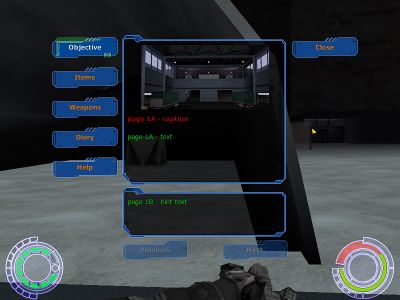XML:OPge
| OPge : Objective Page | 
| |
|---|---|---|
| XML
ONWC << Other file types >> PNTA |
General notes
- The XML on this page is compatible with OniSplit v0.9.61.0.
- OPge*.oni files are level-specific (they can be found in AE/AEInstaller/vanilla/levelX_Final.dat).
- Objective pages can be called via the BSL command "objective_set page_number" or "objective_set page_number silent".
XML structure
Think of "instances" (#N) as file sections; they go from 1 to N. 0 is the header (it defines the file type, here "OPge").
- Every OPge contains one instance of type IGPA.
- Every IGPA contains a number of instances of type IGPG.
- Every IGPG contains a number of instances of type IGSA.
- Every IGSA contains a number of instances of type IGSt.
- IGPA means a page array (think of it as a little book).
- IGPG means a page.
- IGSA means a (text) string array.
- IGSt means a (text) string.
- Be mindful of the structure and it's a piece of cake.
Example from "OPgelevel_21.xml":
- #0 (OPge instance) links to #1 (IGPA instance)
- #1 (IGPA instance) links to #2 (IGPG instance)
- #2 (IGPG instance) links to #3 and #7 (IGSA instances)
- #3 (IGSA instance) links from #4 up to #6 (IGSt instances)
- #7 (IGSA instance) links to #8 (IGSt instance)
XML tags and options
OPge instance tags
- <LevelNumber> (the page won't show up if this tag has the wrong number)
- <Pages> (link to IGPA instance)
IGPA instance tags
- <Pages> (every link represents a page, be aware of it for BSL command "objective_set")
- <Link> (links to an IGPG instance)
IGPG instance tags
- <Font> (defines the font in case it isn't defined in the IGSt instance; the style is bold by default)
- <Family>
- TSFFTahoma
- <Style>
- Normal
- Bold
- Italic
- <Color> (RGB range, e.g. <Color>255 0 77</Color>)
- <Size> (10 and 12 are usually used)
- <Family>
- <Image> (links to a TXMP or PSpc file)
- <Text1> (links to an IGSA instance)
- <Text2> (links to an IGSA instance (hint field))
IGSA instance tags
- <Strings>
- <Link> (links to an IGSt instance)
IGSt instance tags
- <Font>
- <Family>
- TSFFTahoma
- <Style>
- Normal
- Bold
- Italic
- <Color>
- <Size>
- <Flags> (Every IGSt can have its own properties. The <Flag> tag let you enable these. Add "Size" when you want to get a new font size, add "Color" when you want to get a new font color, etc.)
- Family
- Style
- Color
- Size
- <Text> (Contains the actual text, but can also create a bare paragraph (see example at instance #5))
- <Family>
Example
<?xml version="1.0" encoding="utf-8"?>
<Oni>
<OPge id="0">
<LevelNumber>21</LevelNumber>
<Pages>#1</Pages>
</OPge>
<IGPA id="1">
<Pages>
<Link>#2</Link>
</Pages>
</IGPA>
You can display a small image if you use the <Image> tag in the IGPG instance. (Either non-animated TXMP or PSpc.)
<Text2> is used for the hint field — see screenshot ("page 1B - hint text").
<IGPG id="2">
<Font>
<Family></Family>
<Style>Normal</Style>
<Color>0 0 0 0</Color>
<Size>0</Size>
<Flags></Flags>
</Font>
<Image>TXMPmc_big_ware_room</Image>
<Text1>#3</Text1>
<Text2>#7</Text2>
</IGPG>
Instance #5 has a space between the text tags (<Text> </Text>) to produce a new paragraph. OniSplit's import ignores that currently, but you can fix it by writing "<Text xml:space="preserve"> </Text>".
<IGSA id="3">
<Strings>
<Link>#4</Link>
<Link>#5</Link>
<Link>#6</Link>
</Strings>
</IGSA>
<IGSt id="4">
<Font>
<Family></Family>
<Style>Normal</Style>
<Color>191 0 0</Color>
<Size>0</Size>
<Flags>Color</Flags>
</Font>
<Text>page 1A - caption</Text>
</IGSt>
<IGSt id="5">
<Font>
<Family></Family>
<Style>Normal</Style>
<Color>0 0 0 0</Color>
<Size>0</Size>
<Flags></Flags>
</Font>
<Text xml:space="preserve"> </Text>
</IGSt>
<IGSt id="6">
<Font>
<Family></Family>
<Style>Normal</Style>
<Color>0 0 0 0</Color>
<Size>0</Size>
<Flags>Style</Flags>
</Font>
<Text>page 1A - text</Text>
</IGSt>
<IGSA id="7">
<Strings>
<Link>#8</Link>
</Strings>
</IGSA>
<IGSt id="8">
<Font>
<Family></Family>
<Style>Normal</Style>
<Color>0 0 0 0</Color>
<Size>0</Size>
<Flags>Style</Flags>
</Font>
<Text>page 1B - hint text</Text>
</IGSt>
</Oni>
